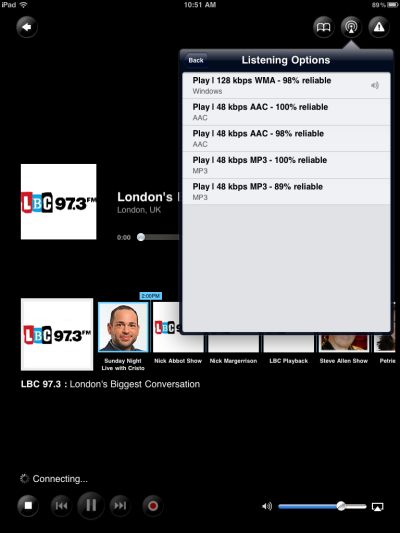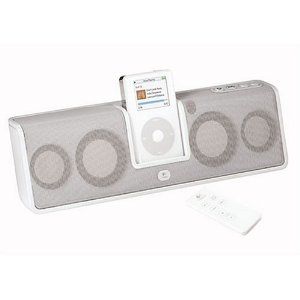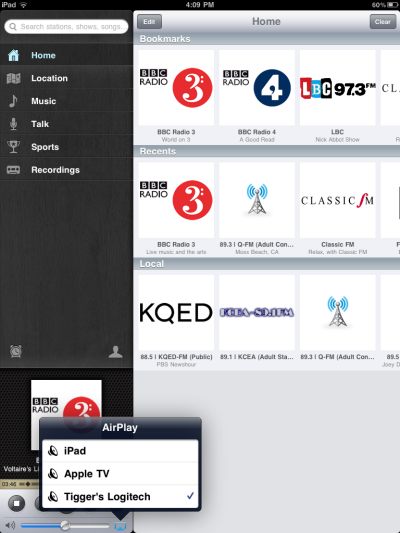A superb app.
This piece has nothing to do with photography but when something as well engineered and executed as the TuneIn Radio app for iPad/iPod/iPhone comes along, it’s hard to resist writing about it.
To those despairing of the culturally arid desert that is American Radio, this app is a must. And it says something about globalization when I tell you that a British Americanophile photographer friend recommended it to this Francophile California UK expatriate!
TuneIn Radio allows you to dial in seemingly any Internet Radio station on the planet (I have yet to check for Pyongyang Hits, and don’t hold your breath on that one) using point and touch maps, and your choices are easily saved as bookmarks. If you get stuttering then it’s a second’s work to switch to a lower bit rate stream using the app’s controls. The app is iOS 4 capable, meaning you can continue to listen while doing other things on your iDevice.

Typical streaming options for a radio station.
I decided to go one step further in distributing the iPad’s (and TuneIn’s) sound output around the home. With yesterday being the annual orgy of shopping which kicks off America’s season of gluttony, I did my bit for the side, got on the old push bike (a British Raleigh, of course) and toddled off to the local Apple Store, sadly far too close for fiscal comfort. They had the Airport Express for sale for $88 and moments later I was home installing it, my second. The first acts as a wifi extender in my office, sourcing its signal from the Airport Extreme router in another room. It also allows me to connect my Brother 2170W printer as a Bonjour printer for use as a wireless printer for any number of computers and iDevices, the latter using FingerPrint which does for iDevices what iOS4 has yet to provide – printing. The 2170W does have built-in native wifi but it stoutly refuses to work with OS Snow Leopard, so the AEX does the trick.

The AEX. The teal light is not that easy to get to ….
For reasons probably only known to Steve Jobs, every Airport Express (AEX) I have owned has been an absolute pig to set up. It must be made by Microsoft. Whereas the Airport Extreme is pretty much plug and play, the AEX is a horror story. You fire up the Airport Utility and hope and pray the new device shows up. Then you hope its configuration will be recognized. Then you learn there are no fewer than three reset modes on the gadget (that should tell you something) and next thing you know you are unbending a paperclip to activate the recessed reset microswitch. After four or five goes the thing comes around and eventually changes its amber trouble light to a teal ‘all is good’ one. At that point I plugged the AEX into the dining room wall socket and using a short mini-coax cable, connected the AEX to my old Logitech MM50 iPod powered speakers. If you buy this cable from the Apple Store then you have more money than sense.

The Logitech MM50 powered iPod speakers.
While the MM50 is long discontinued, and the rechargeable battery in mine died years ago, there are dozens of choices on the market. Just make sure there’s a loudspeaker input socket on the one you buy. That accepts the other end of the cable from the AEX. The MM50 is well made with an Apple-like attention to aesthetics. Unlike most Apple products it actually lasts longer than the warranty period.
The rest is child’s play. Fire up your source app on the iPod/iPhone/iPad of your choice and touch the AirPlay symbol to see a list of output devices.

AirPlay output options in the TuneIn Radio app.
‘Tigger’s Logitech’ routes the sound to my MM50 and each output device remembers its volume setting, so you don’t blow the roof off owing to output level mismatching. I complained to TuneIn’s maker that I couldn’t see the other AEX in the home and they blamed Apple. Wrong. The fault was mine. The list of AirPlay devices scrolls with the swipe of a finger and the other AEX, hidden in the above screenshot, is there when needed. The absence of a scroll bar had me fooled!
Best as I can tell you can only route AirPlay output to one device at a time, but this remains a very cost effective way of outputting sound to any one of multiple locations in the home, controlled with a portable iDevice. Cost per location is as much as you want to spend on powered speakers, but $100 buys you a decent pair and another $100 or so gets you an AEX, so call it $200 per location. Expensive? Have you priced running wires through walls recently? And if you want really good sound with a dedicated DAC, the English gentlemen at Bowers and Wilkins will be glad to relieve you of $600 for their oddly named (if appropriately shaped) Zeppelin which is as good as it gets. You would think the English would be tired of reminders of German aerial bombardment after two wars. Anyway, I’m going to resurrect those old B&W DM5 bookshelf monitors from the basement and maybe spring for a nice tube amp for my next AEX installation …. the output level from the AEX is like that from a preamp, so all you need is a power amplifier and regular unpowered speakers with this approach.

State of the art – the Bowers & Wilkins Zeppelin.

State of stupidity – the $26,000 Challenger01 – you will need two.
When you ripped all those old DVDs to your iPod you did use lossless not MP3, right?